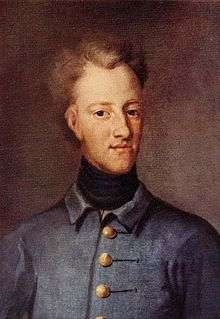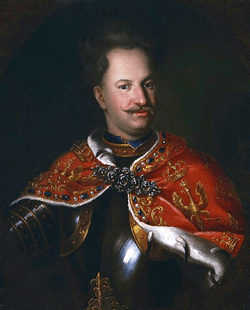Treaty of Warsaw (1705)
The Treaty of Warsaw was concluded on 18 November (O.S.) / 28 November 1705 during the Great Northern War.[1] It was a peace treaty and an alliance between the Swedish Empire and the faction of the Polish-Lithuanian Commonwealth loyal to Stanisław Leszczyński.[1][2]
| Type | Peace treaty, alliance |
|---|---|
| Signed | 18/28 November 1705 |
| Location | Warsaw |
| Parties | Swedish Empire Polish-Lithuanian Commonwealth (Warsaw Confederation) |
| Language | German |
Historical context
Early in the Great Northern War, Charles XII of Sweden campaigned in the Polish-Lithuanian Commonwealth, where Augustus the Strong, Elector of Saxony, was king since 1697.[3] Aimed at dethroning his adversary, Charles XII managed to have his candidate Stanisław Leszczyński elected king of Poland on 12 July 1704.[3] Augustus' ally Peter the Great, tsar of Russia, was reluctant to engage Charles XII in a major battle as a consequence of the decisive defeat his army had suffered at Narva in 1700.[3] A faction of the Polish and Lithuanian nobles did not accept Leszczyński's election,[3] which had been imposed in neglect of the commonwealth's customs, and organized in the Sandomir or Sandomierz Confederation in support of Augustus.[4] They declared the election illegal, outlawed Leszczyński's supporters who were organized in the Warsaw Confederation, declared war on Sweden and allied with Russia in the Treaty of Narva.[5]
A Russo-Saxo-Polish-Lithuanian army was then assembled at Polotsk (Polatsk, Połock, Polockas),[1][5] another allied army in Saxony,[6] and a third allied force commanded by General Otto Arnold von Paykull (Pajkul) advanced towards Warsaw,[1] where Charles XII and Leszczyński sojourned.[5] Pajkul's Saxo-Polish-Lithuanian horse reached the outskirts of Warsaw on 31 July 1705, where they were defeated.[7] The army at Polotsk was denied westward advance by Swedish forces under Adam Ludwig Lewenhaupt.[1] Thus, Leszczyński was crowned king of Poland in Warsaw on 4 October 1705, and Sweden and the faction of the commonwealth represented by Leszczyński signed the treaty of Warsaw on 28 November.[1]
Terms


Sweden was allowed to occupy the Polish-Lithuanian Commonwealth's towns and fortresses and recruit soldiers in its territory without restriction.[1][2] Anti-Swedish alliances concluded by the commonwealth were declared void,[2] Poland was to conclude treaties only with Charles XII's approval.[1]
The commonwealth's regions Courland, Lithuania, Royal Prussia and Ruthenia were to export goods only through the Swedish port of Riga,[2] the Polish port Połąga (Palanga, Palonga) in Courland was to be abandoned.[1][2] In the territory of the commonwealth, Swedish merchants were granted substantial tax exemption and the right to settle and trade.[1]
The treaty further divided the commonwealth's territories then under Russian occupation among the parties: The areas of Smolensk and Kiev were to be re-integrated into Poland-Lithuania, while Polish Livonia and Courland were to be ceded to Sweden upon their reconquest.[2]
For future candidates to the Polish throne, the treaty was made part of the pacta conventa, meaning it had to be supported for any candidacy to become valid.[1]
Aftermath
As intended, the treaty made an inner-Polish-Lithuanian reconciliation of the Warsaw and Sandomir confederations impossible.[1] In early 1706, Augustus the Strong approached Warsaw with a cavalry force and ordered Johann Matthias von der Schulenburg to move the army assembled in Saxony into Poland-Lithuania.[8] Schulenburg was intercepted and defeated by Carl Gustav Rehnskiöld in the Battle of Fraustadt.[6][8] The army assembled in Polotsk had been moved to Grodno (Hrodna, Gardinas, Garten), where it was tactically defeated and forced to withdraw eastwards.[6][8] Charles XII then occupied Saxony, forcing Augustus to abandon both the Polish crown and his allies in the Treaty of Altranstädt (1706).[6][8]
Sources
References
- Bromley (1970), p. 699
- Frost (2000), p. 269
- Anisimov (1993), p. 103
- Anisimov (1993), pp. 103-104
- Anisimov (1993), p. 104
- Anisimov (1993), p. 105
- Bromley (1970), pp. 699-700
- Bromley (1970), p. 700
Bibliography
- Anisimov, Evgeniĭ Viktorovich (1993). The reforms of Peter the Great. Progress through coercion in Russia. The New Russian history. M.E. Sharpe. ISBN 1-56324-047-5.
- Bromley, J. S. (1970). Rise of Great Britain & Russia, 1688-1725. The New Cambridge Modern History. 6. CUP Archive. ISBN 0-521-07524-6.
- Frost, Robert I (2000). The Northern Wars. War, State and Society in Northeastern Europe 1558-1721. Harlow: Longman. ISBN 978-0-582-06429-4.